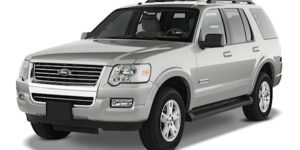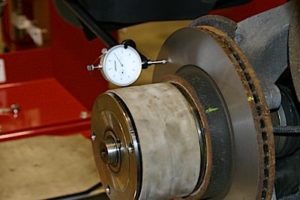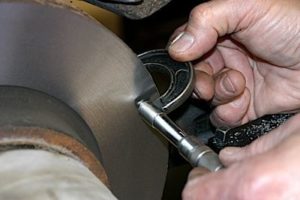 The second-generation Ford Explorer is one of the most common vehicles on the road. The brake system is a product of what Ford learned in the late 1990s about what brakes mean to customer satisfaction. It is a relatively robust and trouble-free system. But, things can still go wrong.
The second-generation Ford Explorer is one of the most common vehicles on the road. The brake system is a product of what Ford learned in the late 1990s about what brakes mean to customer satisfaction. It is a relatively robust and trouble-free system. But, things can still go wrong.
Inspection
On the test drive, listen for any driveline noises. Many older Explorers are known for having problems with the differential, shafts and axles. The most common symptom is a binding or chattering front differential while the vehicle is turning or braking.
Make sure to measure the thickness of the pads. The minimum thickness is 3 mm, which is a lot of material to the naked eye. Ford specifies that the pads cannot vary in thickness from inner to outer pad by more than 2 mm. Also, Ford specifies that there can only be 3 mm of tapered wear.
Technicians are often confused by Ford’s rotor specs. In the past, Ford printed or stamped the “minimum” and “discard” thickness of the rotors. Now, they call it “thickness to machine.” Confused? The minimum thickness is the thickness that the rotors should not drop below before or after machining the rotor. The discard or “thickness to machine” specification is a number (usually 0.7-.9 mm added to the minimum thickness) that should be used to determine if a rotor can be machined.
The rotors should have no more the 0.001” of runout and 0.0004” of thickness variation. While the rotor is off, measure the runout in the wheel bearing hub unit’s flange. The hub unit is one of the first items to fail on the vehicle. In most cases, the first sign of a failure will be an open, erratic or weak wheel speed sensor trouble code.
Brake Rotors Specs
• Front brake rotor minimum thickness: 24.5 mm
(0.9646”)
• Rear brake rotor minimum thickness: 11.0 mm
(0.4331”)
• Front minimum thickness to machine (discard):
25.1 mm (0.98”)
• Rear minimum thickness to machine (discard):
11.6 mm (.45”)
Repair Procedure
When selecting new friction material for the Explorer, keep in mind the original pads were ceramic. The brake system is made for this type of material and how these pads and rotors generate and absorb heat. Going with an overly aggressive semi-metallic pad can create problems with brake fluid temperatures.
For the caliper anchor pins, use a silicone-based brake grease. Make sure it is compatible with all rubber compounds including nitrile, Teflon, nylon and other synthetic rubbers. For the shims, abutment clips and slides, use a synthetic-based boundary-type lubricant that has a high solids content and typically contains a variety of friction-reducing ingredients, such as molybdenum disulfide (moly or MOS2) and graphite.
Ford recommends applying a thin coat of anti-seize lubricant to the hub flange only. Do not allow the lubricant to make contact with the wheel studs, brake pads or brake disc.
 Torque Specs:
Torque Specs:
• Bleeder Screws: 16 ft/lbs
• Front/Rear Hose Banjo/Flow
Bolt: 26 ft/lbs
• Hard Brake Line Fittings: 13
ft/lbs
• Front Caliper Bolt: 24 ft/lbs
• Rear Caliper Bolt: 24 ft/lbs
• Front Caliper Bracket Anchor
Bolts: 100 ft/lbs
• Lug Nuts: 100 ft/lbs
Emergency Brake Adjustments
1. Remove the rear rotor.
2. Inspect the parking/emergency brake mechanism. Lubricate the parking brake shoes at the point where they contact the brake disc shield using silicone grease.
3. Use a brake adjusting gauge/calipers to measure the inside diameter of the drum position of the rear brake disc. Adjust the parking brake shoe clearance of 107 mm (0.142 in.) less than the inside diameter of the drum portion of the rear brake disc.
4. Make sure that the shoes are correctly centered and measure across the center point.
5. Rotate the parking brake shoe adjuster wheel to achieve the correct brake shoe to brake disc clearance.
 Adjusting Parking Cable Tension
Adjusting Parking Cable Tension
1. Remove the LH cowl side trim panel.
2. With the help of an assistant, release the parking brake cable tension by pulling down on the intermediate cable at the cable-to-cable connector clip until the parking brake control sector rotates to a stop and a 4 mm (0.15 in) x 150 mm (5.9 in) retainer pin can be inserted.
3. NOTE: Make sure the cable-to-cable connector clip is connected to the front and rear cable before removing the brake control retaining pin. Also, make sure the cable tension is reloaded slowly. Disconnect the cable-to-cable connector clip.
4. To reload the tension on the parking brake cable, follow the release procedure in reverse.
Bleeding
Ford says that manual bleeding is possible after caliper replacement. But, if you are going to bleed the entire system, start at the right rear, move to the left rear, and finish with the left front. If an ABS hydraulic component is replaced, it will require a scan tool with bi-directional control to get all the air out.














